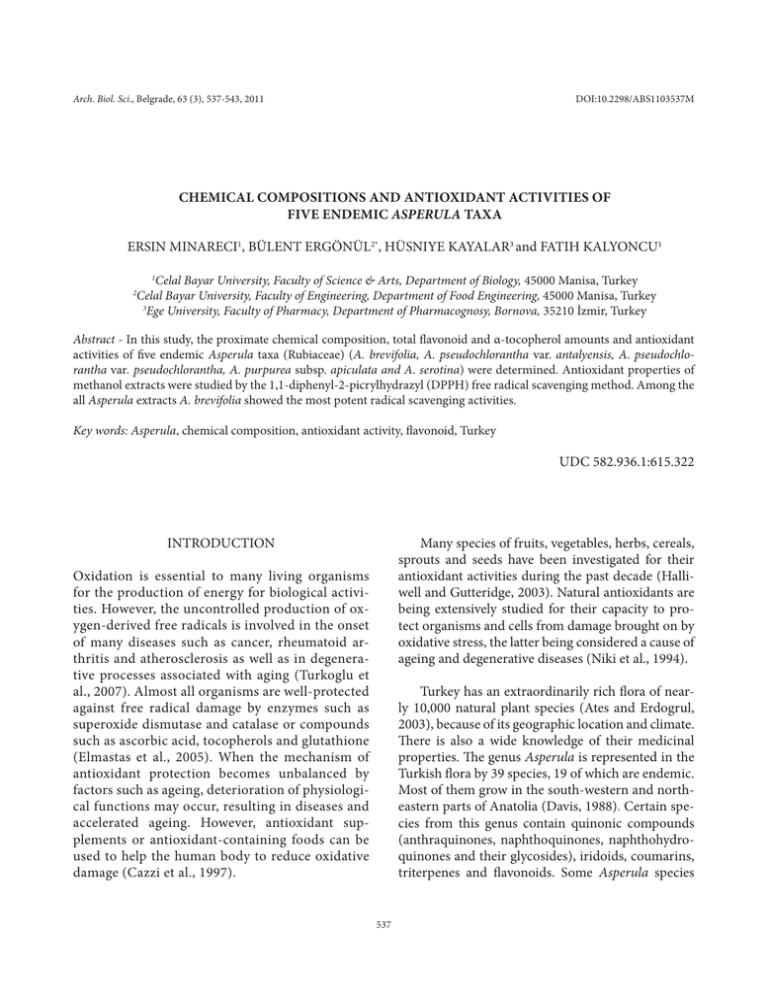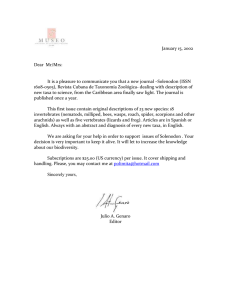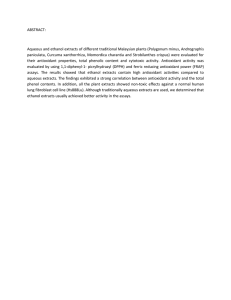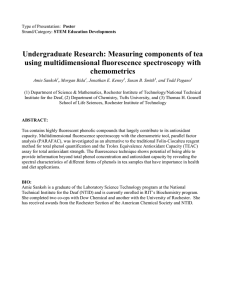Chemical compositions and antioxidant activities of five endemic
advertisement

Arch. Biol. Sci., Belgrade, 63 (3), 537-543, 2011 DOI:10.2298/ABS1103537M CHEMICAL COMPOSITIONS AND ANTIOXIDANT ACTIVITIES OF FIVE ENDEMIC ASPERULA TAXA ERSIN MINARECI1, BÜLENT ERGÖNÜL2*, HÜSNIYE KAYALAR3 and FATIH KALYONCU1 Celal Bayar University, Faculty of Science & Arts, Department of Biology, 45000 Manisa, Turkey Celal Bayar University, Faculty of Engineering, Department of Food Engineering, 45000 Manisa, Turkey 3 Ege University, Faculty of Pharmacy, Department of Pharmacognosy, Bornova, 35210 İzmir, Turkey 1 2 Abstract - In this study, the proximate chemical composition, total flavonoid and α-tocopherol amounts and antioxidant activities of five endemic Asperula taxa (Rubiaceae) (A. brevifolia, A. pseudochlorantha var. antalyensis, A. pseudochlorantha var. pseudochlorantha, A. purpurea subsp. apiculata and A. serotina) were determined. Antioxidant properties of methanol extracts were studied by the 1,1-diphenyl-2-picrylhydrazyl (DPPH) free radical scavenging method. Among the all Asperula extracts A. brevifolia showed the most potent radical scavenging activities. Key words: Asperula, chemical composition, antioxidant activity, flavonoid, Turkey UDC 582.936.1:615.322 INTRODUCTION Many species of fruits, vegetables, herbs, cereals, sprouts and seeds have been investigated for their antioxidant activities during the past decade (Halliwell and Gutteridge, 2003). Natural antioxidants are being extensively studied for their capacity to protect organisms and cells from damage brought on by oxidative stress, the latter being considered a cause of ageing and degenerative diseases (Niki et al., 1994). Oxidation is essential to many living organisms for the production of energy for biological activities. However, the uncontrolled production of oxygen-derived free radicals is involved in the onset of many diseases such as cancer, rheumatoid arthritis and atherosclerosis as well as in degenerative processes associated with aging (Turkoglu et al., 2007). Almost all organisms are well-protected against free radical damage by enzymes such as superoxide dismutase and catalase or compounds such as ascorbic acid, tocopherols and glutathione (Elmastas et al., 2005). When the mechanism of antioxidant protection becomes unbalanced by factors such as ageing, deterioration of physiological functions may occur, resulting in diseases and accelerated ageing. However, antioxidant supplements or antioxidant-containing foods can be used to help the human body to reduce oxidative damage (Cazzi et al., 1997). Turkey has an extraordinarily rich flora of nearly 10,000 natural plant species (Ates and Erdogrul, 2003), because of its geographic location and climate. There is also a wide knowledge of their medicinal properties. The genus Asperula is represented in the Turkish flora by 39 species, 19 of which are endemic. Most of them grow in the south-western and northeastern parts of Anatolia (Davis, 1988). Certain species from this genus contain quinonic compounds (anthraquinones, naphthoquinones, naphthohydroquinones and their glycosides), iridoids, coumarins, triterpenes and flavonoids. Some Asperula species 537 538 ERSIN MINARECI ET AL. are used in folk medicine as a diuretic and tonic and against diarrhoea (Guvenalp and Demirezer, 2005). Despite the considerable medicinal potential of certain plants in Turkey, knowledge of this area and studies on these plants is scarce (Kalyoncu et al., 2006). To the best of our knowledge, no information is available on the antioxidant nature of these plants. Our objective was to evaluate the proximate chemical content and antioxidant activities of five endemic Asperula taxa by the free radical scavenging method. MATERIALS AND METHODS Plant material In this study, five Asperula taxa (Rubiaceae) (A. brevifolia Vent., A. pseudochlorantha var. antalyensis (Ehrend.) Minareci et Yildiz, A. pseudochlorantha Ehrend. var. pseudochlorantha, A. purpurea (L.) Ehrend. subsp. apiculata (Sibth. et Sm.) Ehrend. and A. serotina (Boiss. Et Heldr.) Ehrend) collected from the south-western and north-eastern parts of Anatolia were analyzed for their proximate chemical contents and antioxidant activities. The origin and herbarium numbers of these semi-shrubs are given in Table 1. Voucher specimens were deposited in the Herbarium of Botany, Department of Biology, Celal Bayar University. The aerial parts of these plants used in present study. Antioxidant activity assay The aerial parts of the plants were dried at room temperature and then reduced to a coarse powder. A fine dried plant sample (1 g) was continuously extracted with methanol in a Soxhlet apparatus for 24 h. The methanolic extract was evaporated to dryness at 450C and re-dissolved in methanol, and stored at 4°C prior to further use (Barros et al., 2007). The capacity to scavenge the “stable” free radical DPPH was monitored according to the method of Barros et al. (2007). Different concentrations of methanolic extracts from plants (2 ml) were mixed with 2 ml of a methanolic solution containing DPPH radicals (6x10-5 mol/L). The mixture was shaken vigorously and left to stand for 60 min in the dark (until stable absorption values were obtained). The reduction of the DPPH radical was determined by measuring the absorption at 517 nm. The radical-scavenging activity (RSA) was calculated as a percentage of DPPH discoloration using the equation: % RSA = [(ADPPH – AS) / ADPPH] x 100 where AS is the absorbance of the solution when the sample extract has been added at a particular level and ADPPH is the absorbance of the DPPH solution. The assays were carried out in triplicate and the results expressed as mean values ± standard deviations. BHT was used as standard. Total flavonoid content The flavonoid content in Asperula extracts was determined according to the method of Ahn et al (Ahn et al., 2007). To 3.0 ml of the ethanol extracts of Asperula taxa were added 3 ml of a 2% AlCl3-ethanol solution. After 1 h at room temperature, the absorbance values were measured at 420 nm. The total flavonoid contents were calculated as quercetin equivalents (milligrams per gram) from a calibration curve. Quantitative determination of α-tocopherol (ATOC) by HPLC-UV The plant material was collected and dried at room temperature and reduced to a coarse powder with a Retsch mill. One g of the powdered sample was extracted by 50 ml of n-hexane under ultrasonic stirring. The organic phase was filtered using a 0.45 µm pore diameter filter and evaporated in vacuum. The sample solution was prepared by dissolving the n-hexane extract in methanol and a twenty ml aliquot was injected on the HPLC-UV system (Hiroshi, 2000). Chemical composition assay The water content and total carbohydrates in plant samples were determined according to the Association of Official Analytical Chemists (AOAC, 1995). CHEMICAL COMPOSITIONS AND ANTIOXIDANT ACTIVITIES OF FIVE ENDEMIC ASPERULA TAXA 539 Table 1. Herbarium numbers and origins of Asperula taxa Taxa Coordinate Altitude Herbarium no A. brevifolia N 36° 42’, E 27°34’ 480 m 451-23 A. pseudochlorantha var. antalyensis N 36° 40’, E 30° 32’ 60 m 453-02 A. pseudochlorantha var. pseudochlorantha N 36° 35’, E 30° 30’ 100 m 452-49 A. purpurea subsp. apiculata N 40° 50’, E 27° 23’ 20 m 455-64 A. serotina N 36° 36’, E 33° 03’ 885 m 454-89 Table 2. Extraction yields and antioxidant activity values of Asperula species Taxa Extraction yields (%) RSA (%) Concentration (mg/ml) A. brevifolia 8.40 92.32 ± 0.21 1.68 A. pseudochlorantha var. antalyensis 8.29 91.88 ± 0.42 1.66 A. pseudochlorantha var. pseudochlorantha 9.41 90.77 ± 0.73 1.88 A. purpurea subsp. apiculata 7.91 87.30 ± 0.63 1.58 A. serotina 6.08 85.38 ± 0.21 1.22 98.24 3.00 BHT Table 3. Total flavonoid and α-tocopherol contents in Asperula taxa Taxa Total flavonoid (%) α-tocopherol (%) A. brevifolia 2.49 0.22 A. pseudochlorantha var. antalyensis 2.72 0.66 A. pseudochlorantha var. pseudochlorantha 2.74 0.65 A. purpurea subsp. apiculata 2.90 0.32 A. serotina 1.69 0.32 Table 4. Proximate composition (% dry weight) of five Asperula taxa Taxa Ash Fat Moisture Protein Carbohydrate A. brevifolia 4.66 3.71 7.35 4.20 81.94 A. pseudochlorantha var. antalyensis 4.89 3.98 7.44 3.85 79.85 A. pseudochlorantha var. pseudochlorantha 3.10 5.15 6.94 4.85 79.98 A. purpurea subsp. apiculata 3.74 5.37 6.53 4.31 81.93 A. serotina 5.70 5.37 7.48 6.13 78.01 Total protein was determined by the Kjeldahl method. Protein was calculated using the general factor of 6.25. The weight of fat extracted from 5 g of plant sample was determined to calculate the lipid content (AOAC, 1995). Diethyl ether was used as an extraction solvent and the extraction was performed for 4 540 ERSIN MINARECI ET AL. h. Two grams of the sample were placed in a porcelain container and were ignited and incinerated in a muffle furnace at about 5500C for 8 h until a grayish white ash was obtained (AOAC, 1995). Statistical analysis The data presented are averages of the results of three replicates with a standard error of less than 5%. RESULTS AND DISCUSSION Free-radical scavenging activity The methanol extracts of plant samples were subjected to screening for possible antioxidant activity by the DPPH free radical scavenging method. The model of scavenging the stable DPPH radical is widely used to evaluate antioxidant activities over a relatively short time compared to other methods. DPPH is a stable free radical with a characteristic absorption at 517 nm. As antioxidants donate protons to these radicals, the absorption decreases. The decrease in absorption is taken as a measure of the extent of radical scavenging. Free radical scavenging values of Asperula extracts as percentage are shown in Table 2. Methanol extracts of A. brevifolia showed the strongest radical scavenging effect (92.32%) at 1.68 mg/ml. This activity was followed by A. pseudochlorantha var. antalyensis (91.88%) and A. pseudochlorantha var. pseudochlorantha (90.77%) respectively (Table 2). The lowest scavenging activity was exhibited by A. serotina (85.38%). However, the scavenging effect for BHT was 98.24% at 3.0 mg/ml. The yields of methanol extracts of Asperula taxa are given in Table 2. In previous studies, the antioxidant activities of methanolic extracts of several plants have been reported (Assimopoulou et al., 2004, Al Fatimi et al., 2007). Özgen et al. (2003) found that methanolic extracts of Onosma argentatum and Rubia peregrina scavenged 98.00 and 94.20% of DPPH radicals, respectively. At 1.0 mg/ml, the methanolic extracts of Acacia nilotica, Aerva javanica, Solanum Fig. 1. Standard quercetin curve used for the determination of the total flavonoid content nigrum and Tamarindus indica scavenged 94.62, 91.80, 95.30 and 93.86%, respectively (Al Fatimi et al., 2007). Total flavonoid contents Table 3 shows the total flavonoid contents of Asperula taxa. Using the standard curve of quercetin (R2=0.9987) (Fig. 1), the total flavonoid contents in Asperula taxa ranged from 1.69 to 2.90%. A. purpurea subsp. apiculata had the highest value (2.90%), while A. serotina had the least (1.69%). Flavonoids are commonly found in both edible and non-edible plants, and they have been reported to have multiple biological effects, including antioxidant activity. Flavonoids have been suggested to play a preventive role in the development of cancer and heart disease (Ahn et al., 2007). The AlCl3 coloration is currently used to determine the total flavonoid contents (Liu et al., 2007). Prasad et al. (2009) reported that, total flavonoid contents of Cinnamomum burmanni and C. tamala are 0.274 and 0.056%, respectively. Quantitative determination of α-tocopherol (ATOC) by HPLC-UV Tocopherols are considered to be the most effective lipid phase natural antioxidants. They prevent lipid peroxidation by acting as peroxyl radical CHEMICAL COMPOSITIONS AND ANTIOXIDANT ACTIVITIES OF FIVE ENDEMIC ASPERULA TAXA 541 scavengers that terminate chain reactions in membranes and lipoprotein particles (Traber and Atkinson, 2007). The levels of ATOC (vitamin E) in medicinal plants would make them suitable sources of these antioxidants. Theu could be used commercially to retard rancidity in fatty materials, to reduce the effects of ageing and to help to prevent oxidative stress-related diseases such as cancer and heart disease (Dewick, 2002). Peaks obtained during quantitative determination of ATOC are given as Fig. 2. The amounts of alpha-tocopherol in five Asperula taxa are presented in Table 3. A. pseudochlorantha var. antalyensis had the highest content of ATOC (0.66%) and A. brevifolia had the lowest (0.22%). Barros et al. (2010) reported that the ATOC contents of Castanea sativa and Helichrysum stoechas were 0.124 and 0.066%, respectively. Proximate analysis assay Proximate analysis was carried out on five endemic Asperula taxa. The results of proximate composition are presented in Table 4. A. serotina had the highest concentration of protein (6.13%), followed by A. pseudochlorantha var. pseudochlorantha and A. purpurea subsp. apiculata, while A. pseudochlorantha var. antalyensis had the least (3.85%). With respect to the moisture content, A. serotina had the highest value (7.48%) and A. purpurea subsp. apiculata the lowest (6.53%). A. brevifolia had the highest carbohydrate content (81.94%); ash was highest in A. serotina (5.70%). The ether extract (fat) values are between 3.71% (A. brevifolia) and 5.37% (A. serotina and A. purpurea subsp. apiculata) (Table 4). Fig. 2. Quantitative determination of α-tocopherol by HPLCUV; A, A. brevifolia; B, A. pseudochlorantha var. antalyensis; C, A. pseudochlorantha var. pseudochlorantha; D, A. purpurea subsp. apiculata; E, A. serotina. The protein contents of the plants analyzed in this study were lower than those obtained in previous studies; Madibela et al. (2002) reported that the protein contents of Tapinanthus lugardii, Viscum verrucosum and V. rotundifolium are 11.9, 7.9 and 12.8% respectively. Also, the protein contents of Centella asiatica, Erythrina crista and Lasia spinosa, were as reported by Maisuthisakul 542 ERSIN MINARECI ET AL. et al. (2008), i.e. 12.7, 24.2 and 17.9% respectively. In the same study, the ash contents were 12.6, 7.7 and 1.3%, the fat contents were 6.2, 5.1 and 3.8%, and the carbohydrate contents were 53.1, 40.3 and 45.5% respectively. CONCLUSIONS Antioxidant properties of plants are usually related to low-molecular weight compounds, in particular to the phenolic fractions. A wide range of these potentially beneficial phenolic compounds could be natural substrates of oxidative enzymes such as peroxidases or polyphenol oxidases that are present in high levels in some plants (Barros et al., 1997). On the basis of the presented results, the extract of Asperula taxa could be of use as an easily accessible source of natural antioxidant and used for nourishment. However, at present, the active component in the extract which is responsible for the observed antioxidant activity is unknown. Therefore, further work, involving the isolation and purification of the active components from the crude extracts of Asperula taxa is required in order to examine the mode of action. As far as our literature survey could ascertain, there is no information about the antioxidant activities and chemical compositions of the Asperula taxa presented here. REFERENCES Ahn, M.R., Kumazawa, S., Usui, Y., Nakamura, J., Matsuka, M., Zhu, F., and T. Nakayama (2007). Antioxidant activity and constituents of propolis collected in various areas of China, Food Chem. 101, 1383-1392. Al-Fatimi, M., Wurster, M., Schröder, G., and U. Lindequist (2007). Antioxidant, antimicrobial and cytotoxic activities of selected medicinal plants from Yemen, J. Ethnopharmacol. 111, 657-666. AOAC. (1995). Official methods of analysis. (16th Ed.), Association of Official Analytical Chemists, Arlington VA, USA. Assimopoulou, A.N., Boskou, N., and V.P. Papageorgiou (2004). Antioxidant activities of alkannin, shikonin and Alkanna tinctoria root extracts in oil substrates, Food Chem. 87, 433-438. Ates, D.A., and T.O. Erdogrul (2003). Antimicrobial activities of various medicinal and commercial plant extracts, Turk. J. Biol. 27, 157–162. Barros, L., Oliveira, S., Carvalho, A.M., and I.C.F.R. Ferreira (2010). In vitro antioxidant properties and characterization in nutrients and phytochemicals of six medicinal plants from the Portuguese folk medicine, Ind. Crop. Prod. 32, 572-579. Barros, L., Ferreira, M.J., Queiros, B., Ferreira, I.C.F.R., and P. Baptista (2007). Total phenols, ascorbic acid, β-carotene and lycopene in Portuguese wild edible mushrooms and their antioxidant activities, Food Chem. 103, 413-419. Cazzi, R., Ricardy, R., Aglitti, T., Gatta, V., Petricone, P., and R. De Salvia (1997). Ascorbic acid and β-carotene as modulators of oxidative damage, Carcinogenesis, 18, 223 – 228. Davis PH, 1998. Flora of Turkey and the East Aegean Islands. Vol. VII, Edinburgh University Press, Edinburgh., pp 734-761. Dewick, P.M. (2002). Medicinal Natural Products, John Wiley and Sons, Lda., Elmastas, M., Gulcin, I., Ozturk, L., and I. Gokce (2005). Investigation of antioxidant properties of spearmint (Mentha spicata L.), Asian J. Chem. 17, 137 – 148. Guvenalp, Z., and L.O. Demirezer (2005). Flavonol glycosides from Asperula arvensis L., Turk. J. Chem. 29, 163 – 169 Halliwell, B., and J.M.C. Gutteridge (2003). Free radicals in biology and medicine. Oxford University Press, Oxford, U.K. Hiroshi, I. (2000). Determination of tocopherol acetate in emulsified nutritional supplements by solid-phase extraction and high-performance liquid chromatography with fluorescence detection, J. Chromatogr. A, 881: 243-249. Kalyoncu, F., Cetin, B., and H. Saglam (2006). Antimicrobial activity of common madder (Rubia tinctorum L.), Phytother. Res. 20, 490 – 492 Liu, M., Li, X.Q., Weber, C., Lee, C.Y., Brown, J., and R.H. Liu (2004). Antioxidant and anriproliferative activities of raspberries, J. Agr. Food Chem. 50, 2926-2930. Maisuthisakul, P., Pasuk, S., and P. Ritthiruangdej (2008). Relationship between antioxidant properties and chemical composition of some Thai plants, J. Food Compos. Anal. 21, 229-240. Madibela, O.R., Letso, M., Boitumelo, W.S., Masedi, M., and K. Alton (2002). Chemical composition of four parasitic plants harvested over a period of 6 months from two sites in Botswana, Anim. Feed Sci. Tech. 95, 159-167. Niki, E., Shimaski, H., and M. Mino (1994). Antioxidantism-free radical and biological defence. Gakkai Syuppan Center, Tokyo. CHEMICAL COMPOSITIONS AND ANTIOXIDANT ACTIVITIES OF FIVE ENDEMIC ASPERULA TAXA 543 Özgen, U., Houghton, P.J., Ogundipe, Y., and M. Coşkun (2003). Antioxidant and antimicrobial activities of Onosma argentatum and Rubia peregrine, Fitoterapia 74, 682-685. Traber, M.G., and J. Atkinson (2007). Vitamin E, antioxidant and nothing more, Free Radical Bio. Med. 43, 4-15. Prasad, K.N., Yang, B., Dong, X., Jiang, G., Zhang, H., Xie, H., and Y. Jiang (2009). Flavonoid contents and antioxidant activities from Cinnamomum species, Innov. Food Sci. Emerg. 10, 627-632. Turkoglu, A., Duru, M.E., Mercan, N., Kivrak, I., and K. Gezer (2007). Antioxidant and antimicrobial activities of Laetiporus sulphureus (Bull.), Murrill. Food Chem. 101, 267 – 273.






